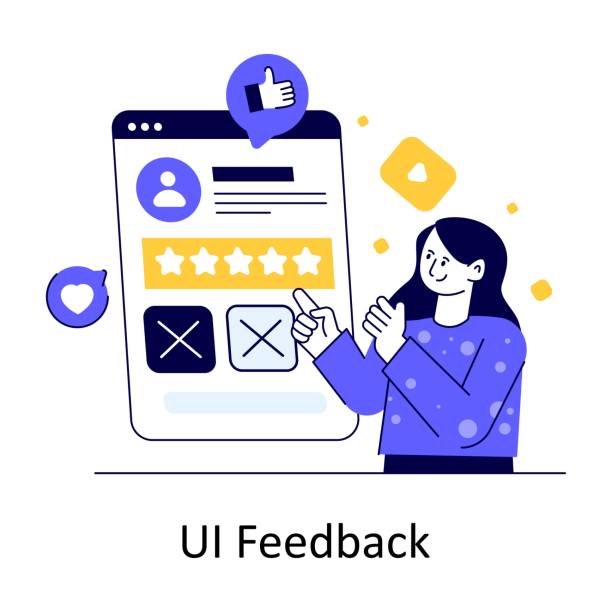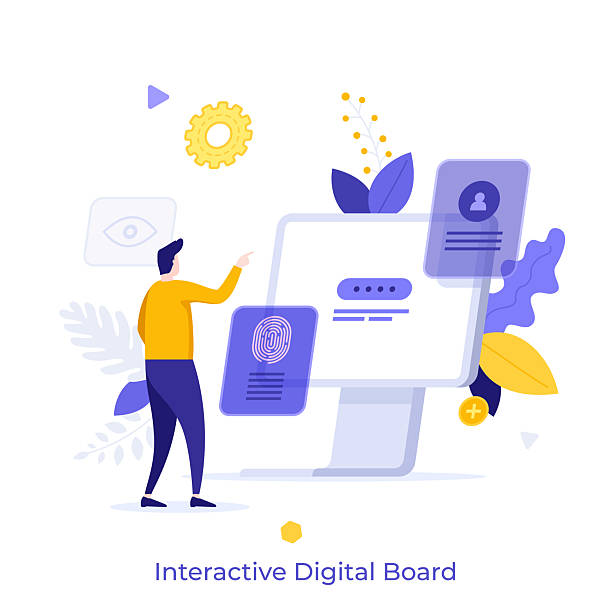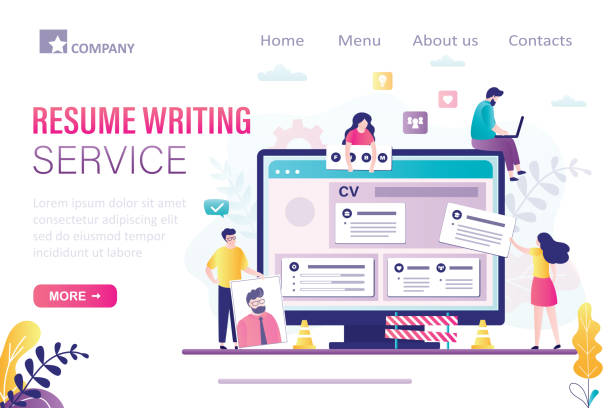Introduction to Responsive Website Design: Why is it Important?

In today’s digital world, where users access the internet from a variety of devices, the concept of #Responsive_Web_Design has become more important than ever.
It is no longer possible to expect the best #User_Experience across all platforms with a single, static version of a website.
This approach allows websites to automatically adapt their size and layout to the user’s screen size, from large desktops to tablets and smartphones.
The main goal of responsive website design is to provide a unified and optimized user experience, regardless of the device the user is using.
This not only leads to improved user satisfaction but also plays a vital role in #SEO_optimization and increasing website #accessibility.
In this educational and explanatory article, we will deeply explore the various dimensions of responsive design and discuss key tips for its successful implementation.
Tired of losing business opportunities due to not having a professional corporate website? Don’t worry anymore! With Rasaweb’s corporate website design services:
✅ Your brand’s credibility and professionalism will increase.
✅ You will attract more customers and sales leads.
⚡ Get a free consultation now to get started!
Technical Principles of Responsive Design: How Does it Work?

Responsive website design is based on specific technical foundations that allow websites to be flexible.
The three main pillars of this approach include Fluid Grids, Flexible Images, and Media Queries.
Fluid grids use relative units like percentages for element widths instead of fixed pixel units.
This allows the page layout to change dynamically depending on the display size.
Flexible images are also scaled using CSS so that they never overflow their container and are always displayed proportionally to the available space.
This technique prevents layout disruption and the need for horizontal scrolling.
However, the heart of responsive website design is Media Queries.
This CSS3 feature allows developers to apply different style rules based on device characteristics, such as screen width, height, orientation (portrait or landscape), and even resolution.
For example, it can be specified that for widths less than 768 pixels, the navigation menu should turn into a hamburger button and fonts should be smaller.
This specialized capability enables the creation of completely different experiences for mobile and desktop users without the need for separate code.
This combination of principles allows the website to intelligently react to the user environment and optimize the content viewing experience.
Benefits of Responsive Website Design for Users and Businesses

The benefits of responsive website design go beyond a simple technical aspect and have profound effects on user experience and business performance.
For users, this approach means easy and seamless access to content on any device.
There is no longer a need for annoying zooming or horizontal scrolling.
All elements, from text to images and buttons, are adjusted to have better readability and clickability.
This improvement in user experience directly positively impacts engagement rates, time spent on the site, and ultimately, user satisfaction.
From a business perspective, responsive website design brings several strategic advantages.
Search engines like Google prefer responsive websites over separate mobile websites because managing a single codebase is easier and it avoids duplicate content issues.
This leads to improved SEO rankings and increased organic traffic.
Furthermore, maintaining and updating only a single website reduces the costs and time required for development.
This analytical and explanatory approach shows that investing in responsive website design is a smart and long-term decision for any online business.
| Category | Main Benefit | Description |
|---|---|---|
| Users | Unified User Experience | Easy and seamless access to content on any device (mobile, tablet, desktop). |
| Businesses | Improved SEO and Google Ranking | Search engines prefer responsive websites and give them higher rankings. |
| Developers | Reduced Maintenance Costs | A single codebase for all devices leads to reduced development and maintenance time and cost. |
Popular Tools and Frameworks for Responsive Design

To facilitate the responsive website design process, numerous tools and frameworks have been developed that significantly simplify the work of developers.
One of the most well-known and widely used is Bootstrap.
Bootstrap is a CSS, HTML, and JavaScript framework that includes pre-designed templates for typography, forms, buttons, tables, navigations, and other UI components.
This framework is designed with a “Mobile-First” approach and offers powerful tools for creating responsive layouts, including a flexible grid system and utility classes for displaying or hiding elements at different screen sizes.
In addition to Bootstrap, other frameworks like Foundation and Bulma are also popular options, each with its own features and design philosophies.
Using these frameworks allows developers to implement responsive websites with higher speed and efficiency, without needing to write all the CSS code from scratch.
These frameworks are particularly useful for large projects and development teams, ensuring that the website displays correctly on all devices.
This section provides guidance on choosing the right tools for effectively implementing responsive website design.
Are you frustrated with your online store’s low conversion rate?
Rasaweb, with its professional e-commerce website design, is your definitive solution!
✅ Increase your sales and revenue
✅ Provide an unparalleled user experience for your customers
⚡ Get a free consultation now!
Challenges and Common Mistakes in Responsive Design

Despite its many advantages, responsive website design is not without challenges, and developers may encounter common mistakes along the way.
One of the biggest challenges is performance management.
If images are not properly optimized or CSS and JavaScript codes are too heavy, site loading times on mobile devices can significantly increase, leading to a poor user experience and high bounce rates.
Website speed optimization is a crucial element in the success of a responsive website.
Another common mistake is neglecting testing on real devices.
Simulators and browser tools can be useful, but they cannot fully replicate the user experience on different devices, especially regarding touch interactions and hardware performance.
Overly complex mobile design is also a pitfall; sometimes simplifying the user interface for smaller screens is harder than it seems.
Responsive website design requires a mobile-first mindset, not just adapting a desktop layout to smaller screens.
Neglecting hidden content on mobile (e.g., using tabs or accordions) and ensuring its accessibility are also common mistakes.
Addressing these challenges requires careful planning, continuous optimization, and comprehensive testing to create a truly responsive and efficient website.
This section provides thought-provoking and analytical content to make developers aware of potential mistakes.
Designing for Different Devices: The Mobile-First Approach

One of the most important paradigms in responsive website design is the “Mobile-First” approach.
This approach means starting the design and development process by considering the smallest screen size (usually mobile).
Instead of designing for desktop and then trying to adapt it to mobile, in the mobile-first approach, the user interface and site functionality are first optimized for mobile devices.
This means that only the most essential content and functionality are initially designed and coded.
Then, as screen real estate increases, more features and details are gradually added for tablets and desktops (a process known as progressive enhancement).
This way of thinking not only helps simplify the design but also makes the website inherently faster and more efficient, as additional resources are only loaded when needed.
The mobile-first approach, by focusing on the limitations of mobile devices (such as slow connection speeds, small screens, and touch interaction), helps designers prioritize content and features better.
This is especially crucial given the growing trend of mobile use for internet access.
This specialized and guiding section highlights the importance of strategic thinking in responsive website design.
Impact of Responsive Design on SEO and Google Ranking

Responsive website design is considered a crucial factor in modern Search Engine Optimization (SEO) strategies.
Google has adopted a “Mobile-First Indexing” approach for years, meaning it indexes and ranks websites based on their mobile version.
If your website is not optimized for mobile, it will likely rank lower in mobile search results (and even desktop results).
A responsive website, by providing a single URL and a shared codebase for all devices, avoids duplicate content issues and the complexities associated with managing multiple versions of a site.
Furthermore, site loading speed (Page Speed), which is an important Google ranking factor, is well-managed in responsive websites, provided the necessary optimizations are performed.
Tools like Google PageSpeed Insights can help you evaluate and improve your site’s speed.
A positive user experience, which is a direct result of proper responsive website design, also indirectly affects SEO; lower bounce rates, longer time spent on site, and higher conversion rates all send positive signals to Google.
This analytical and explanatory section demonstrates why responsive website design is essential not only for users but also for online visibility.
| SEO Factor | Impact of Responsive Design | Description |
|---|---|---|
| Mobile-First Indexing | Improved Ranking | Google uses the mobile version of the site for indexing and ranking. |
| Page Load Speed | Increased Speed | With proper optimization, responsive sites load faster. |
| User Experience (UX) | Positive Signal to Google | Good UX leads to lower bounce rates and more engagement, which is beneficial for SEO. |
The Future of Web Design: New Trends in Responsiveness

The future of responsive website design is accompanied by continuous innovations and new trends that further enhance the user experience.
One of these trends is the use of Artificial Intelligence and Machine Learning for dynamic optimization and content personalization based on the user’s device and behavior.
These technologies can automatically optimize layouts, images, and even content for each user.
Progressive Web Apps (PWAs) also play an increasing role in the future of responsive design.
PWAs, by combining features of websites and mobile applications (such as offline capability, push notifications, and access to device hardware capabilities), offer a much richer user experience on mobile devices while maintaining their responsive nature.
Other trends include Dark Mode design, which has become popular in many operating systems and applications, and the use of Responsive Typography, which adjusts font size and spacing based on screen size.
Additionally, there is an increasing focus on interactive design and lightweight animations that help improve the visual experience without harming performance.
This news and analytical section provides a glimpse into the future path of responsive website design and shows how this field continues to evolve.
Are your online sales not what you expected? With Rasaweb, permanently solve the problem of low sales and poor user experience!
✅ Increase your visitor-to-customer conversion rate
✅ Create an enjoyable user experience and boost customer trust
⚡ Act now to receive a free consultation!
Successful Case Studies in Responsive Design

To better understand the effectiveness and practical application of responsive website design, a look at some successful case studies can be very inspiring.
Many global brands and large companies, by correctly implementing responsive design, have significantly improved their user experience and, as a result, increased their interactions and revenues.
For example, major news websites like BBC News or The New York Times use responsive design to deliver their content optimally across various devices.
This allows millions of users to effortlessly access the latest news, whether they are reading on a desktop or browsing on their smartphone on the subway.
Additionally, e-commerce platforms such as Amazon and Etsy fully leverage the principles of responsive design to provide a seamless shopping experience across all devices.
This approach allows users to view products, add them to their cart, and complete the checkout process without any issues, regardless of the device they are using.
These real-world examples clearly demonstrate how responsive website design can become a competitive advantage and help businesses achieve their goals.
This engaging and educational section provides tangible examples of the successful application of responsive design.
Conclusion and Next Steps for Your Website

As discussed throughout this specialized and guiding article, responsive website design is no longer a luxury option but a vital necessity for any website that wants to succeed in today’s digital landscape.
From improving user experience and increasing customer satisfaction to enhancing search engine rankings and reducing maintenance costs, the benefits of implementing this approach are countless.
Given the ever-growing use of mobile devices to access the internet, investing in responsive website design is an investment in the future of your business.
For businesses and developers who have not yet fully moved in this direction, the next steps are clear:
-
Assess current status: Use tools like Google Mobile-Friendly Test or Lighthouse to measure the responsiveness of your current website.
-
Detailed planning: Develop a mobile-first strategy for redesigning or optimizing your website.
-
Choose the right tools: Select appropriate frameworks and tools based on your team’s needs and skills.
-
Continuous testing and optimization: After implementation, regularly test your website on real devices and perform necessary optimizations to improve performance.
By adopting responsive website design, you will not only have a more user-friendly and SEO-friendly website, but you will also prepare your business for success in the decades to come.
Frequently Asked Questions
| Question | Answer |
|---|---|
| What is Responsive Web Design? | A method of website design that ensures the website displays well across various screen sizes and devices (such as mobile, tablet, desktop) and provides a suitable user experience. |
| Why is responsive design important? | Improved user experience, better SEO (Google prefers responsive sites), time and cost savings (no need to build a separate site for mobile). |
| What are the main techniques in responsive design? | Using flexible grids and layouts (Fluid Grid), flexible images and media, and using Media Queries in CSS. |
| What are Media Queries in responsive design? | A part of CSS3 that allows you to apply different styles based on the characteristics of the device on which the website is displayed (such as screen width, resolution, media type). |
| What are the benefits of using responsive design? | Access to more users (especially mobile), improved user engagement rates, reduced maintenance costs (one site for all devices), and improved conversion rates. |
And other advertising services of Rasaweb Advertising Agency:
Smart Link Building: An effective tool to increase sales with the help of attractive UI design.
Smart Sales Automation: A fast and efficient solution for analyzing customer behavior with a focus on precise audience targeting.
Smart Sales Automation: Transform online growth with custom programming.
Smart Data Analysis: An innovative platform for improving customer acquisition using real data.
Smart Custom Software: A fast and efficient solution for improving SEO ranking with a focus on SEO-driven content strategy.
And over hundreds of other services in internet advertising, advertising consultation, and organizational solutions.
Internet Advertising | Advertising Strategy | Advertorials
Resources
Comprehensive Guide to Responsive DesignMobile-First Strategy in Website DesignSEO Benefits in Responsive DesignFuture Web Design Trends
? To elevate your business in the digital world, Rasaweb Afarin Digital Marketing Agency, specializing in SEO, online advertising, and user-friendly website design, is with you to ensure a powerful and lasting online presence.
📍 Tehran, Mirdamad Street, next to Bank Markazi, Southern Kazeroon Alley, Ramin Alley, No. 6




